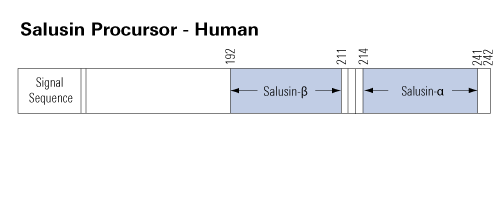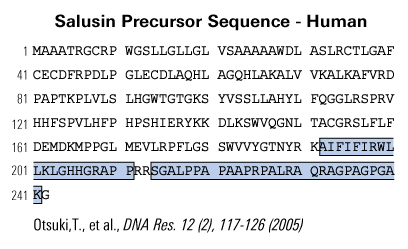
(a) Human TOR2A comprises five exons (open boxes) and four introns (bold lines).(b) Predicted TOR2A and preprosalusin mRNAs. Salusin polypeptide's are encoded in exons 3 and 5 of TOR2A. Arrows with solid bars indicate primers used for conventional RT-PCR. Arrows with dotted bars indicate the positions of primers, and two small boxes denote hybridization probes, both used for LightCycler hybridization probe format for quantification of TOR2A (HYB-1) and preprosalusin (HYB-2).(c) Predicted amino acid sequence of preprosalusin. An arrowhead shows the signal-sequence cleavage site. Horizontal bars indicate salusin polypeptide's.Shichiri et al. Nat Med. 2003 Sep;9(9):1166-72. Epub 2003 Aug 10.



Salusin-alpha is a new bioactive peptide with mild hypotensive and bradycardic effects. Our recent study showed that salusin-alpha suppresses foam cell formation in human monocyte-derived macrophages by down-regulating acyl-CoA:cholesterol acyltransferase-1, contributing to its anti-atherosclerotic effect. To clarify the clinical implications of salusin-alpha in hypertension and its complications, we examined the relationship between serum salusin-alpha levels and carotid atherosclerosis in hypertensive patients. The intima-media thickness (IMT) and plaque score in the carotid artery, blood pressure, serum levels of salusin-alpha, and atherosclerotic parameters were determined in 70 patients with essential hypertension and in 20 normotensive controls. There were no significant differences in age, gender, body mass index, fasting plasma glucose level, or serum levels of high-sensitive C-reactive protein, high- or low-density lipoprotein (LDL) cholesterol, small dense LDL, triglycerides, lipoprotein(a), or insulin between the two groups. Serum salusin-alpha levels were significantly lower in hypertensive patients than in normotensive controls. The plasma urotensin-II level, maximal IMT, plaque score, systolic and diastolic blood pressure, and homeostasis model assessment for insulin resistance (HOMA-IR) were significantly greater in hypertensive patients than in normotensive controls. In all subjects, maximal IMT was significantly correlated with age, systolic blood pressure, LDL cholesterol, urotensin-II, salusin-alpha, and HOMA-IR. Forward stepwise multiple linear regression analysis revealed that salusin-alpha levels had a significantly independent and negative association with maximal IMT. Serum salusin-alpha levels were significantly lower in accordance with the severity of plaque score. Our results suggest that the decrease in serum salusin-alpha, an anti-atherogenic peptide, may be associated with carotid atherosclerosis in hypertensive patients.
Watanabe T, Suguro T, Sato K, et al. Hypertens Res. 2008;31(3):463-8.
The mas-like G protein-coupled receptors form a subfamily of G protein-coupled receptors that includes variable member numbers across different species and that have been shown to bind a wide variety of ligand's from peptides to amino acid derivatives. While screening a library of peptides against different orphan G protein-coupled receptors, we found that human salusin beta activates the mouse mas-like G protein-coupled receptor, mMrgA1 with an EC(50) of about 300 nM. Salusin beta is a bio-active peptide recently discovered through bioinformatics analysis which stimulates arginine-vasopressin release from rat pituitary and causes rapid and profound hypotension and bradycardia. However, when we further analyzed the generality of the mMrgA1 activation, we found that human salusin beta does not activate corresponding human mas-like G protein-coupled receptors. Our results show that human salusin beta is a surrogate ligand of the mouse MrgA1 and raises a cautionary flag for experiments that analyze the pharmacological profiles of mas-like G protein-coupled receptors from different species.
Wang Z, Takahashi T, Saito Y, et al. Eur J Pharmacol. 2006;539(3):145-50.
The discovery of endogenous bio-active peptides has typically required a lengthy identification process. Computer-assisted analysis of cDNA and genomic DNA sequence information can markedly shorten the process. A bioinformatic analysis of full-length, enriched human cDNA libraries searching for previously unidentified bio-active peptides resulted in the identification and characterization of two related peptides of 28 and 20 amino acids, which we designated salusin-alpha and salusin-beta. Salusin's are translated from an alternatively spliced mRNA of TOR2A, a gene encoding a protein of the torsion dystonia family. Intravenous administration of salusin-alpha or salusin-beta to rats causes rapid, profound hypotension and bradycardia. Salusin's increase intracellular Ca(2+), up regulate a variety of genes and induce cell mitogenesis. Salusin-beta stimulates the release of arginine-vasopressin from rat pituitary. Expression of TOR2A mRNA and its splicing into preprosalusin are ubiquitous, and immuno-reactive salusin-alpha and salusin-beta are detected in many human tissues, plasma and urine, suggesting that salusin's are endocrine and/or paracrine factors.Shichiri M, Ishimaru S, Ota T, Nishikawa T, Isogai T, Hirata Y. Nat Med. 2003;9(9):1166-72.
| Catalog# | Product | Standard Size | Price |
|---|---|---|---|
| 010-68 | Salusin-beta (Human) | 100 µg | $167 |
| EK-010-67 | Salusin-alpha (Human) - EIA Kit | 96 wells | $570 |
| EK-010-67CE | Salusin-alpha (Human) - EIA Kit, CE Mark Certified | 96 wells | $595 |
| 010-74 | Salusin, 40mer (Human) | 100 µg | $299 |
| T-010-74 | Salusin, 40mer (Human) - I-125 Labeled | 10 µCi | $1082 |
| 010-73 | Salusin, 50mer (Human) | 100 µg | $287 |
| H-010-73 | Salusin, 50mer (Human) - Antibody | 100 µl | $571 |
| B-G-010-73 | Salusin, 50mer (Human) - Biotin Labeled Purified IgG | 100 µl | $629 |
| FC3-G-010-73 | Salusin, 50mer (Human) - Cy3 Labeled Purified IgG | 100 µl | $944 |
| FC5-G-010-73 | Salusin, 50mer (Human) - Cy5 Labeled Purified IgG | 100 µl | $944 |
Social Network Confirmation